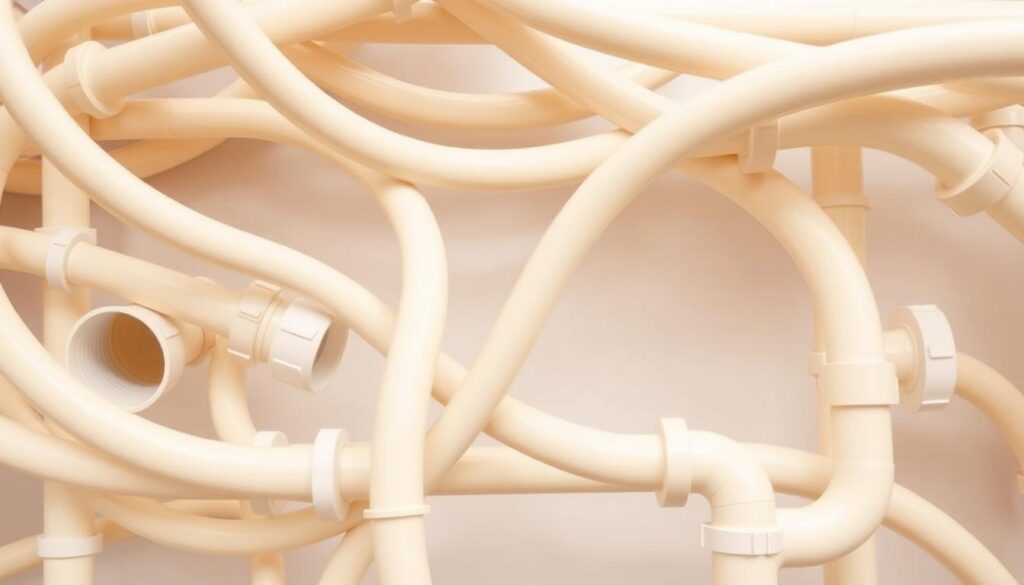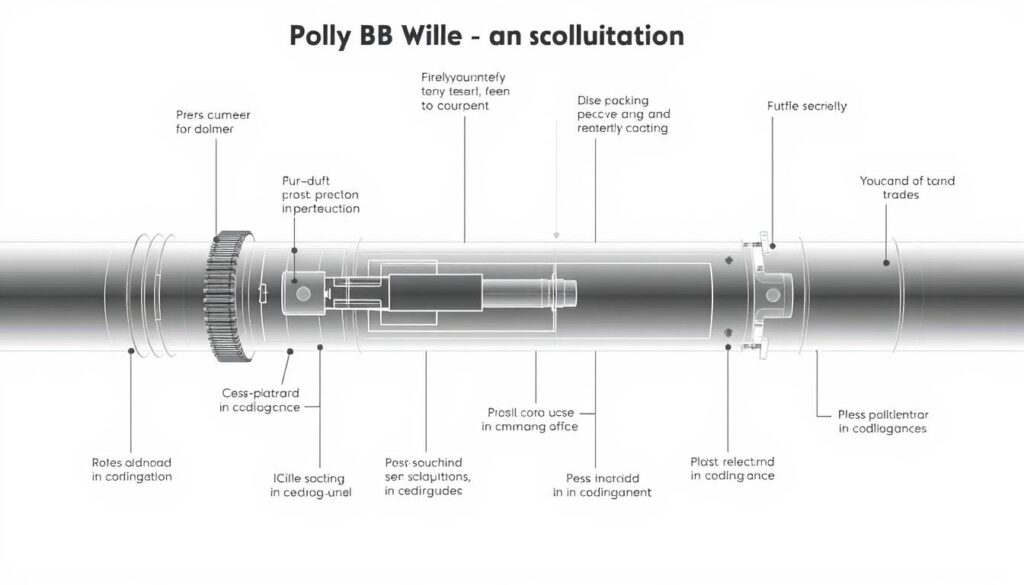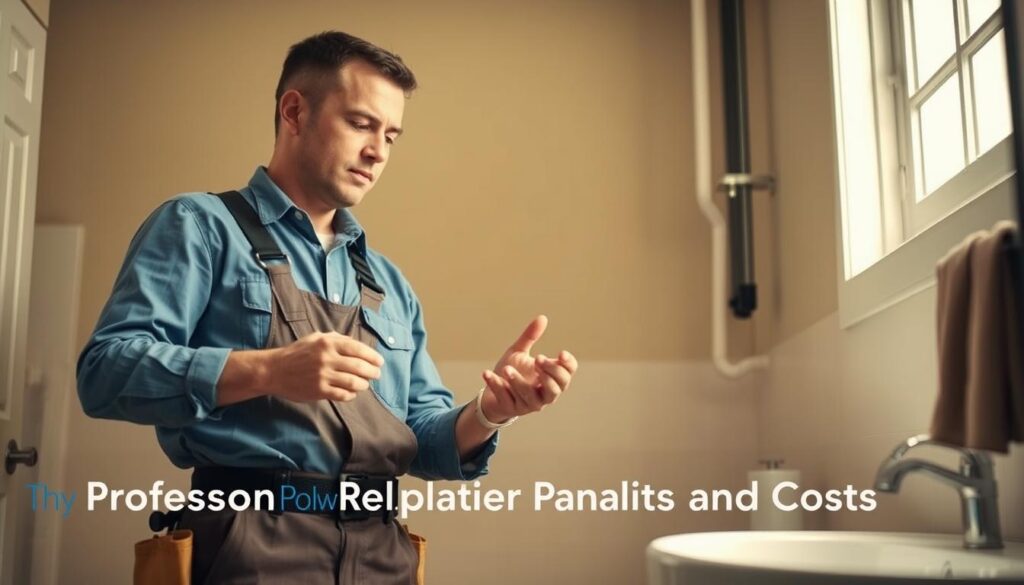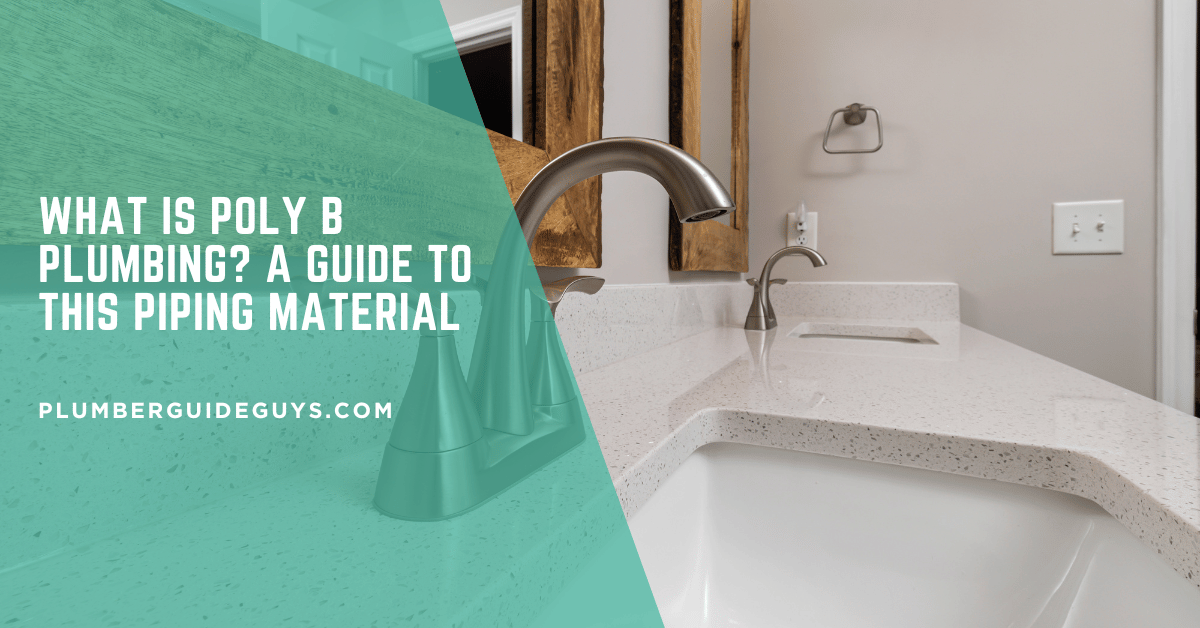Affiliate Disclosure
Plumber Guide Guys is a participant in the Amazon Services LLC Associates Program, an affiliate advertising program designed to provide a means for sites to earn advertising fees by advertising and linking to Amazon.
Did you know over 10 million homes in the U.S. got polybutylene piping from 1978 to 1995? What is poly b plumbing, and why is it important for homeowners? It was seen as a cheaper option than copper pipes.

Poly B plumbing is a type of plastic piping used in homes from the late 20th century. It was marketed as flexible and affordable for water systems in many homes.
Knowing the risks of polybutylene piping is key for homeowners, mainly those in houses built during its peak. These pipes can lead to serious problems that might harm your home’s water system.
Key Takeaways
- Poly B plumbing was widely used between 1978 and 1995
- These pipes were marketed as an affordable copper alternative
- Potential structural risks exist with polybutylene piping
- Homes with Poly B pipes may face insurance challenges
- Professional inspection is recommended for older plumbing systems
Table of Contents
Understanding Poly B Plumbing Basics
Exploring what is poly b plumbing takes you back to the 1970s and 1980s. Polybutylene pipes were seen as a new, flexible, and affordable option. They were meant to replace traditional metal pipes.
Poly B plumbing is a type of plastic pipe that was popular in homes. These pipes were often light grey or light blue. They had a rubbery feel, unlike metal pipes.
The Development of Polybutylene Pipes
The story of Poly B pipes started with big dreams. Engineers wanted a pipe that was light, didn’t corrode, and would change plumbing forever. Poly B plumbing lifespan was expected to be long and reliable.
Material Composition and Properties
- Flexible plastic material
- Lightweight construction
- Resistant to mineral buildup
- Lower installation costs compared to metal pipes
Historical Usage in Residential Construction
Poly B pipes were used in many homes in North America at their peak. Builders liked how easy they were to install and how affordable they were.
| Period | Usage Characteristics |
|---|---|
| 1975-1985 | Initial development and limited adoption |
| 1985-1997 | Peak installation period in residential constructions |
| 1998-2005 | Decline and eventual phase-out |
Homeowners should understand that while Poly B pipes were once considered innovative, they ultimately revealed significant performance limitations.
What is Poly B Plumbing and Its Characteristics
To understand poly b plumbing, you need to know its special traits. Polybutylene pipes were common in homes from the late 1970s to the 1990s. They are easy to spot because of their unique look.
Poly B pipes stand out because of their colors:
- Light gray
- Light blue
- Dark gray
Identifying poly b pipes is simple. They have a “PB” mark and a number on them. These pipes were once seen as cutting-edge for water systems in homes.
Poly b plumbing is found in many places in your home:
- Under sinks
- Behind walls
- In basement areas
- Connected to water heaters
Important note: Poly b pipes were flexible, making them easy to install. But, this flexibility led to big problems later on.
Poly B pipes were a new idea that didn’t last in home plumbing systems.
The Rise and Fall of Polybutylene Piping
Polybutylene pipes were once a big hit in homes, seen as cheap and new. In the 1970s and 1980s, they were everywhere in the U.S. Millions of homes had them.
- They cost less than copper pipes
- They were easy to put in
- They didn’t corrode easily
- They worked well in many settings
Market Withdrawal Triggers
But, problems started showing up in the late 1980s and early 1990s. Homeowners found:
- Pipes breaking without warning
- Big water damage
- Structures getting weak in certain conditions
Legal Challenges
Then, lawsuits piled up. Big companies faced huge legal battles because of pipe failures. A big lawsuit led to a $1 billion settlement. This ended polybutylene’s use in homes.
Industry Impact
By the mid-1990s, making polybutylene pipes stopped. The big lawsuit showed the pipes had big problems. The construction world had to find better plumbing options.
Common Signs of Poly B Pipe Deterioration
Spotting early signs of poly b pipe failure can prevent expensive water damage and big plumbing fixes. Poly b plumbing issues can creep up slowly. It’s key to know the main signs of pipe wear.
If your home’s plumbing shows these signs, it might be failing:
- Unexpected water leaks in walls, ceilings, or floors
- Sudden drops in water pressure
- Discolored or cloudy tap water
- Visible pipe damage such as cracking or blistering
- Unexplained water stains or moisture around pipe connections
Water damage is a big risk with poly b plumbing issues. Small leaks can turn into big problems fast. They can harm your home’s foundation and inside areas. Watch for any unusual moisture or water marks near your plumbing.
When you see many warning signs, get a pro to check it out. Skilled plumbers can find out how bad the pipe failure is. They’ll tell you what to do next.
“Early detection is key to preventing extensive water damage and costly home repairs.” – Plumbing Experts Network
Don’t wait for a big plumbing disaster. Keep an eye on your pipes and fix issues early. This way, you can stop big problems before they start.
Risk Factors Affecting Poly B Pipe Performance
Poly B plumbing problems can harm your home’s water system. It’s key to know the main risks to polybutylene pipes. This helps homeowners avoid water damage and expensive fixes.
Temperature Stress and Pipe Integrity
Polybutylene pipes face big risks from temperature changes. High heat can weaken the pipes, leading to failures. The material of Poly B pipes gets less stable in extreme heat, speeding up wear.
- Temperatures above 180°F can cause rapid pipe deterioration
- Consistent hot water exposure increases pipe fragility
- Thermal expansion creates internal stress on pipe walls
Chemical Exposure Vulnerabilities
Chlorine and other chemicals in water can harm Poly B pipes. These substances can break down the pipes, causing cracks and failure.
| Chemical Agent | Potential Impact | Degradation Rate |
|---|---|---|
| Chlorine | Molecular breakdown | High |
| Mineral Deposits | Internal pipe scaling | Moderate |
| Oxidizing Agents | Surface deterioration | Moderate to High |
Installation Quality Challenges
Bad installation can make polybutylene pipes more risky. Issues like wrong connections, not enough support, and bad fitting can ruin the plumbing.
- Incorrect pipe connection methods
- Insufficient pipe support structures
- Inadequate expansion joint implementation
- Poor sealing techniques
Getting a pro to check your Poly B plumbing can spot risks and stop big water damage. Regular checks and upkeep are key to handling Poly B plumbing issues well.
Identifying Poly B Pipes in Your Home

Learning to identify poly b pipes is key to protecting your home’s plumbing. These pipes were common in homes built in the 1970s and 1980s. Knowing how to spot them is important.
Poly B pipes stand out due to their unique features. They are gray, flexible plastic with clear markings. These markings make them easy to recognize.
- Look for gray-colored plastic pipes
- Check for printed markings with “PB” or “Poly B”
- Inspect common locations like under sinks and in basements
- Examine pipes connected to water heaters
To find poly b pipes in your home, look in these places:
| Location | Likelihood of Poly B Pipes |
|---|---|
| Unfinished Basement | High |
| Under Kitchen Sink | Medium |
| Water Heater Connections | High |
| Exposed Ceiling Pipes | Medium |
Pro tip: If you’re not sure about your pipes, get a plumber’s help. They can tell you for sure what you have.
Look at the pipe’s look and feel. Poly B pipes are smooth, gray, and bendy. They have marks from the maker. They look and feel different from PVC or copper pipes.
Remember, finding poly b pipes early can stop water damage and save you money on repairs.
The Impact on Home Insurance Coverage
Poly B piping can make it hard for homeowners to get insurance. Many insurers see the risks of polybutylene pipes as big problems. This affects how much you can insure your home for and what options you have.
Understanding Insurance Policy Limitations
Most homeowners insurance policies are careful with poly b. Insurers know the risks of polybutylene pipes. This can lead to:
- Restricted coverage for water damage
- Higher premium rates
- Potential policy cancellation
- Mandatory pipe replacement requirements
Coverage Options for Homes with Poly B
Getting insurance with poly b plumbing needs careful planning. Some insurers offer special plans for homes with polybutylene pipes:
- Specialized Insurance Riders: Specific add-on policies addressing poly b piping risks
- Comprehensive Replacement Coverage
- Risk Mitigation Policies
Fixing your polybutylene piping system can help get better insurance terms. It’s important to talk to insurance experts who know about poly b pipes. They can help protect your home’s value and get you the right coverage.
Comparing Poly B to Modern Plumbing Materials
Understanding what is poly b plumbing is key. It’s important to see how it stacks up against today’s options. Poly B was once a go-to but has been replaced by better materials.
The debate between poly b and pex shows big strides in plumbing tech. PEX, or cross-linked polyethylene, is now the top choice. It offers many benefits:
- Enhanced durability and flexibility
- Resistance to chemical degradation
- Better performance in extreme temperatures
- Lower installation costs
| Characteristic | Poly B | PEX |
|---|---|---|
| Chemical Resistance | Poor | Excellent |
| Lifespan | 10-15 years | 40-50 years |
| Temperature Tolerance | Limited | High |
Modern materials like PEX offer better, longer-lasting plumbing. Poly B, once seen as cutting-edge, is now outdated. It’s prone to failure and can cause water damage.
Your home’s plumbing is a big investment. Choosing modern materials means better performance, less upkeep, and higher value.
Professional Replacement Options and Costs
Replacing poly b plumbing is a big home improvement project. It needs careful planning and expert help. Fixing poly b plumbing problems involves important steps to keep your water system safe and working well.

Homeowners should know what affects the cost of replacing poly b plumbing. The cost is usually between $3,000 and $8,000. This depends on several things:
- Home square footage
- Number of bathrooms
- Pipe accessibility
- Local labor rates
- Chosen replacement material
Getting a licensed plumber to check your system is key. They will look closely to find the best way to replace your poly b plumbing.
| Replacement Material | Estimated Cost per Linear Foot | Durability |
|---|---|---|
| PEX Piping | $2 – $4 | 25-40 years |
| Copper Piping | $4 – $6 | 50+ years |
| CPVC Piping | $1 – $3 | 20-25 years |
“Proactive replacement of poly b plumbing can prevent water damage and costly repairs later.” – Professional Plumbing Association
When picking a contractor, ask for detailed quotes and check their licenses and insurance. Doing your homework ensures a successful plumbing replacement project.
Maintenance Tips for Existing Poly B Systems
To keep poly b plumbing systems working well, regular maintenance is key. Homeowners with older pipes can take steps to avoid big problems. These steps help prevent major failures.
It’s important to know the special challenges of poly b plumbing. These pipes can be tricky, but the right care can help. This care can lower the risk of big issues.
Pressure Management Strategies
Lowering water pressure is a big help. Here are some tips:
- Install a pressure-reducing valve
- Maintain water pressure below 60 PSI
- Regularly check pressure with a professional gauge
- Address any sudden pressure fluctuations immediately
Temperature Control Methods
Water temperature affects how long poly b pipes last. Here are some ways to manage it:
- Keep water heater set below 120°F
- Use insulation for pipe protection
- Avoid extreme temperature variations
- Install thermal expansion tanks
Regular Inspection Protocols
Regular checks are essential to catch problems early. Here’s what to do:
- Annual professional pipe assessments
- Check for visible signs of deterioration
- Monitor water quality and pressure changes
- Document and track pipe condition
Remember, while these maintenance strategies can help, they are temporary solutions. Ultimately, replacement remains the most reliable long-term approach for poly b plumbing systems.
Steps to Protect Your Home from Poly B Failures
To keep your home safe from polybutylene piping risks, you need to act early. Poly b pipe failure can seriously harm your property. It’s very important to prevent it, mainly for homes with older plumbing.
- Install advanced water leak detection systems
- Monitor water pressure regularly
- Control water temperature settings
- Conduct annual plumbing inspections
Water leak detection technology is key in managing polybutylene piping risks. Modern systems can warn you of problems before they get worse. They track water flow and can turn off your main water supply if they find leaks.
Keeping water pressure low is also important. Lower pressure means less stress on your pipes. Installing a pressure-reducing valve can help. It keeps water pressure between 40-60 PSI, which can make your pipes last longer.
If you’re worried about your plumbing, talk to a professional plumber. They can assess your polybutylene pipes and help you plan a replacement.
“Prevention is always more cost-effective than emergency repairs” – Professional Plumbing Association
While these steps can help, replacing your pipes is the best long-term solution. This is true for homes with polybutylene piping.
Conclusion
Knowing about poly b plumbing is key for homeowners to protect their homes. Poly B pipes can be a big risk to your plumbing system. They can cause expensive water damage and structural issues.
Replacing poly b plumbing is a smart move for your home’s safety and value. Experts can help you find and fix any pipe problems. This is important for keeping your home safe.
Being proactive is important. By knowing the risks of Poly B pipes, you can protect your home’s water system. This prevents unexpected failures and keeps your home’s structure strong.
Choosing to replace old Poly B pipes is a smart choice. It keeps your home safe, saves on repair costs, and gives you peace of mind. Talking to licensed plumbers helps you make the best choice for your home.

